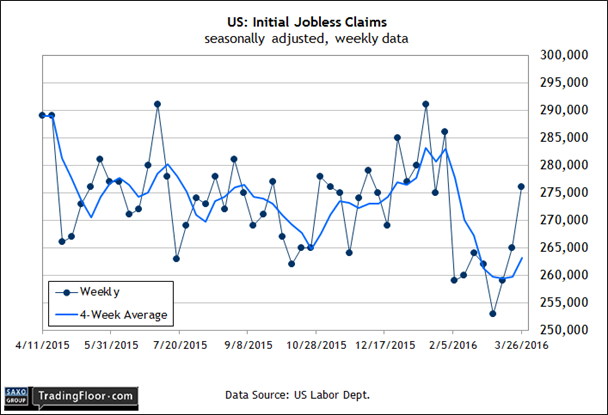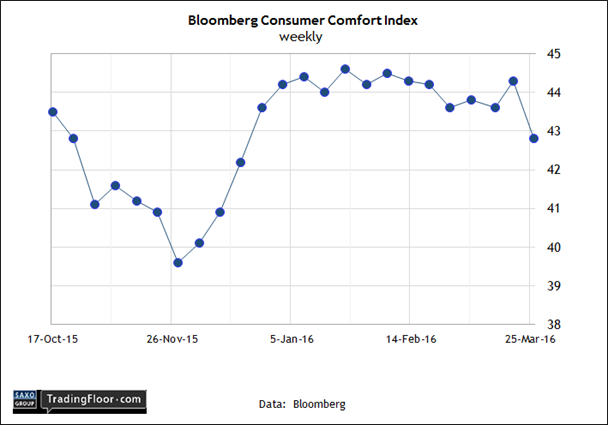- The recent slide in Germany’s 10-year bond yield leaves rate close to all-time low
- US jobless claims are expected to decline for the first time in a month
- Bloomberg’s US Consumer Comfort Index may touch a new year-to-date low
- Wage stagnation has helped to curb consumer spending in the US
The crowd will be closely monitoring Germany’s benchmark 10-year yield today, which has been sliding lately and is now close to last year’s all-time low. Meantime, two weekly US numbers will provide more context for evaluating the macro trend in March: Initial jobless claims and Bloomberg’s sentiment data via the Consumer Comfort Index.
Germany 10-Year Bond Yield: Economic growth in the Eurozone looks set to carry on at a modest 0.3% quarterly rate in next month’s first-quarter GDP report. But the relatively upbeat outlook hasn’t curbed the renewed appetite for the safe haven trade.
Germany’s 10-year bond yield has been fall persistently over the past month, dipping just below 0.10% on an intraday basis this week before settling just above that round number as of mid-day trading on Wednesday.
The renewed move to shift assets into the 10-year bund is a sign that macro worries are rising. Germany’s economy in particular faces new uncertainty as slower growth in the global economy takes a bite out of Europe’s largest economy, which relies on exports to a comparatively high degree. Notably, softer growth in emerging markets has turned into a stronger headwind for Germany lately.
This week’s news that factory orders fell unexpectedly in February for the euro area’s main economy heightens the concern that lower foreign demand will be a factor for the foreseeable future. Indeed, the Economy Ministry on Tuesday noted that while domestic orders increased 0.9%, foreign demand sagged 2.7% in February.
By some accounts, weaker growth going forward is all but a foregone conclusion. “Global economic uncertainties and problems have clearly hampered Eurozone growth so far in 2016,” the chief European and UK economist at IHS Global Insight said earlier this week.
The headwind is a factor “not only through limiting exports but also through weighing down appreciably on business and consumer confidence, which has negative implications for employment, investment and consumption decisions”.
The key question in the days and weeks ahead: Will the 10-year yield challenge the all-time low of just below 0.05% reached in April 2015? For the moment, the market’s in a holding pattern. But another round of weaker economic numbers - for Germany and the Eurozone overall - will foster a new leg down for the 10-year yield. In short, a new record low for this benchmark rate may be approaching.

US: Initial Jobless Claims (1230 GMT): The surge in jobless claims in recent weeks looks a bit worrisome, although it could turn out to be another false alarm. If so, it wouldn’t be the first time that this volatile but valuable leading indicator threw the crowd a curve ball. But the stakes are modestly higher than usual after surprisingly weak readings for two broad-minded measures of the labour market in March.
As I discussed on Monday, updates to benchmarks published by the Federal Reserve and the Conference Board point to slower job growth in the months ahead. But last month’s solid gain in nonfarm payrolls suggests otherwise. Perhaps today’s weekly data on new filings for unemployment benefits will clarify the outlook, for better or worse.
Keep in mind that big picture expectations took a hit this week after the downgrade in the Atlanta Fed’s widely followed GDPNow model. This relatively reliable forecast currently projects that first quarter economic growth for the US will dip to a stall-speed rate of just 0.4% in the “advance” Q1 report that’s due later this month.
The good news is that economists think that today’s update for claims will be a non-event. Econoday.com’s consensus forecast calls for slight decline in new filings to 272,000 (seasonally adjusted), which would mark the first fall in a month. If so, the news will help dial down worries that the labour market is stumbling.

US: Bloomberg Consumer Comfort Index (1345 GMT) : The mood on Main Street perked up a bit in March, according to the final reading of the University of Michigan’s Consumer Sentiment Index.
Over the past nine months, this benchmark has been treading water. “This stability reflected more positive personal finances being offset by less favorable prospects for the economy,” said the chief economist who oversees the data.
Meantime, the weekly figures for the Bloomberg Consumer Comfort Index stumbled in late March. Is that a sign that April will be a rough month for consumer expectations? Today’s update of CCI will bring another clue for assessing the mood via the closing value for the first quarter.
The previous update hinted at a softer trend in the final days of Q1: CCI dipped to 42.8 for the week through March 26. "Consumer caution the past few weeks is unsurprising," noted the president of Langer Research Associates, which crunches the numbers for the index on behalf of Bloomberg. “While strong employment numbers and tentative signs of improvement in a weak housing market are positives, wages remain mostly stagnant and consumer spending has underperformed.”
Another decline in today’s update will stoke more questions about what’s in store for the second quarter with regards to consumer spending, including next week’s March release on retail sales. In particular, will the tepid rise in consumption in February roll on? Today’s CCI data will be closely read as the crowd looks for fresh guidance.

Disclosure: Originally published at Saxo Bank TradingFloor.com
